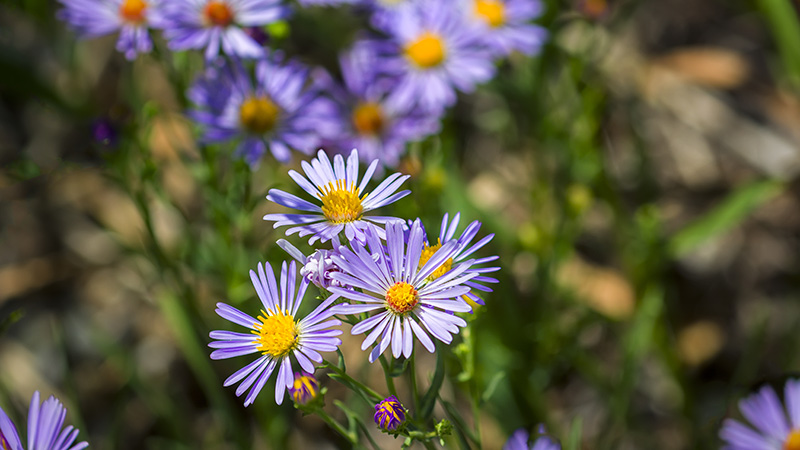October 8, 2019
Even after this year’s heavy snowpack, the Colorado River Basin states are experiencing increasingly dry conditions. The Colorado River and its tributaries are more stressed than ever due to over-use and climate change. So we all need to make every drop count and help ensure the West has a secure water future.
At WRA, we are working to help states and communities across our region make the most of the water we have. But you can make a difference too – right in your own back yard – by choosing native, drought-resistant plants that require less water and provide other benefits, from increasing shade and humidity to providing pleasant smells, attracting pollinators and birds, and beautifying our lives with vibrant splashes of color.
There are many great choices for drought resistant plants to fill your different needs. Here are a few suggestions to get you started:
Drought Resistant Plant #1: Prairie Sage
Nothing quite embodies the resilient spirit of the West and its arid, high desert plains like sage. A sacred plant for many native cultures, and a common sight for anyone who has taken a long road trip across the region in almost any direction, this native shrubbery can add an element of style to your landscaping while keeping your water needs minimal. This subtle, blue-green bush has evolved to thrive on the dry high plains of the West, and it tolerates the cold winters across the northern part of our region.
Drought Resistant Plant #2: Aromatic Aster
Another drought resistant native option to brighten up any garden in the West, aromatic aster thrives in elevations up to about 8,000 feet in gardens with rocky, sandy soil, sun and a little shade. It can do well in a variety of different soils, making it a versatile option to spruce up your yard. These beautiful fall-blooming flowers will help fill your yard with butterflies and are a great option to make your garden friendlier for bees. Despite its delicate appearance, these plants do well through the winter, and are a resilient option for a beginning gardener.
Drought Resistant Plant #3: Chocolate Daisy
Who doesn’t love chocolate? If you are looking for the sweet smell of chocolate subtly wafting through your yard from spring into summer, well then chocolate daisy is the drought resistant variety you need! With sunny yellow petals and a darker brown center – from which they get their chocolatey perfume and name – these delicate sunflower lookalikes are native to the Rocky Mountain Range. Some varieties also are more resistant to cold, making them another great addition for drought resistant planting in Western states with harsh winters.
Drought Resistant Plant #4: Prickly Pear Cactus
If you live in one of our drier regions, consider prickly pears, some of the best known cacti in the West. Prickly pear cactus is a surefire way to give your backyard a Southwestern feel, and the breathtaking bloom of its flowers can give any area a splash of color when warmer temperatures roll around.
Drought Resistant Plant #5: Red Sulfur Buckwheat
Red sulfur buckwheat may technically be a native wildflower of the West, but it is also a resilient, easy-to-grow shrub that will bloom into brilliant shades of red as the summer burns on. Red sulfur buckwheat is another great choice to help make your yard more pollinator friendly and attract native butterflies, while adding color to your yard’s palette. There are many varieties of sulfur buckwheat, so you can select different versions of this Western native plant to find the color and characteristics that best fit your needs.
Drought Resistant Plant #6: Rocky Mountain Penstemon
Searching for a little color to accent your garden or brighten up your yard? Add a pop of purple in the form of Western native and drought resistant Rocky Mountain penstemons! These tall, lively perennials are a great way to add some soothing energy to your summertime yard. Native to the Rocky Mountains and happy in their home soil, these penstemons are well-suited to cold winters. Plant some of these water-savvy locals and add some vibrant shades of violet to your plant portfolio while you cut back on your water bill.
And for your lawn, ponder a waterwise change:
Drought Resistant Plan #7: Buffalograss
When you think of drought resistant landscaping, your first thought might be of stone-dominated xeriscaping and mulch, but native grasses like buffalograss are better adapted to our semi-arid Western climates, and therefore require less water. They can also tolerate the heat better than more familiar grass options like Kentucky bluegrass. While this drought tolerant native option is more water conscious, it doesn’t mean it will be less green! Buffalograss is a great option if you want more conventional-looking landscape that still allows you to cut back on your water use.
Whether you’re looking to freshen up landscaping and cut back on your water use, or add a little regional flavor into your outdoor areas without the need for additional irrigation, these drought resistant plants can give you a leg up on your garden game, while helping reduce your impact on water supply in the West! From colorful perennials to evergreen succulents and cute cacti, these drought resistant plant varieties are a great choice for the landscaper who needs confidence through our wild and increasingly unpredictable seasons. And they’re a dependable way to help keep more water in our rivers and lakes.










